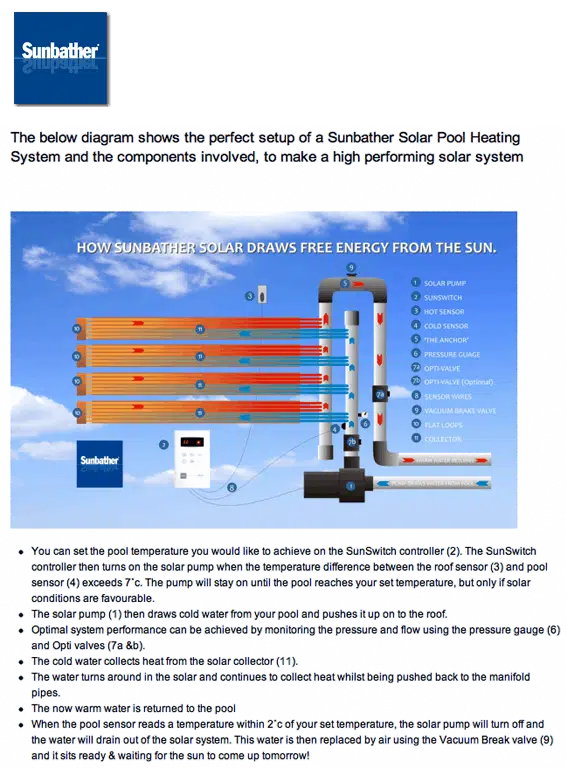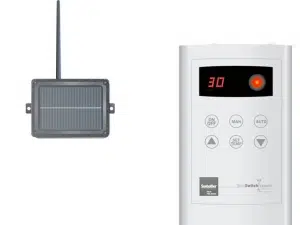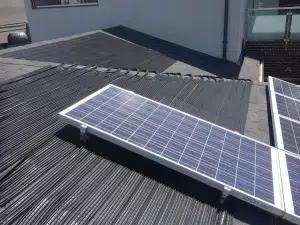
Solar Pool Heating

Solar Pool Heating
Installing solar pool heating can extend the use of your pool by up to four-6 months pending where you liv win Australia. By using the heating energy from the sun, the cost to keep your pool warm in this way is extremely economical.
The type of solar system may differ; though, the basic principal stays the same. Pool water is circulated through a number of tubes (the collector) typically mounted on the roof, where the sun’s heat is absorbed and the heated water returned to the pool. The collector can be of either EPDM rubber or PVC/TPR material and is generally supplied in multiple tube “strips” or panels.
The amount of heat absorbed and the ultimate rise in pool water temperature depends on numerous factors which should be thought out when deciding on a solar heating system for your pool. They are;
- Size or area of collector and amount of tubes or panels per square metre. Naturally the main influence on the effectiveness of any solar system is its exposure to the sun, therefore,
- Location or positioning of collector
- Control system
The number of collectors used in your solar system will have a key impact on the effectiveness of the system. The size of the collector is normally measured in square metres, and as a general rule, directly relates to the surface area of the pool.
Australian standard AS3634 advise a minimum collector area equivalent to 60% of the surface area of the pool, only in desired conditions, for systems in the Sydney, Newcastle and Wollongong areas. We would recommend up to 80-100% coverage usually and even more if the pool is shaded or roof does not get full sun.

The total area of collector usually needs to be raised depending on variables such as; local climate, shading of roof or pool, slope and orientation of roof, wind protection, type and colour of roof and collector type. Larger systems will be required where higher than average water temperature, or extended swimming season is anticipated. In accordance with the above, SPASA recommends a minimum area of 80% for the majority of installations. The “area” referred to in relation to collector size is the area of actual collector strip not the roof onto which it is to be placed. Australian Standard AS3634 specifics the way in which the effective width of collector strip is to be determined for calculating collector area. The formula is N x (W + D) where N= number of tubes, D= tube diameter and W= web width between tubes. (The maximum web width which can be used can’t be more than one tube diameter per tube).
Collectors (other than those on flat roofs) should preferably be positioned on north facing roofs. Deviation is acceptable if collector area is increased accordingly. Collector should be positioned to avoid shade from objects ie; trees, neighbouring houses etc for at least six hours every day.
Remember, the following will affect the size and location of your solar system;
- Pool surface area
- Roof orientation
- Shade on collector or roof
- Colour of roof

To circulate water through the solar system you can pick to use either the existing pump or provide a dedicated pump.
If the existing pump is to be used it should meet the following conditions;
- The required rate of turnover of the pool water for filtration purposes must be maintained
- The opening pressure of the filter should not be increased above the manufacturer’s maximum pressure by the addition of the solar circuit
- The pump shall have sufficient capacity to handle the static head and friction losses introduced by the addition of the collector circuit
The average domestic solar installation needs a minimum flow rate of about 100 to 200 litres per minute to operate effectively. In many circumstances, this would mean a dedicated solar pump would be necessary.
Constantly check that the minimum design flow rate of the collector is met when picking your pump. This flow rate will differ with the diameter of the tubing used.
The circulated water needs to be strained to avoid blocking up the collector with dirt and debris, so when using a dedicated pump, any form of strainer must be provided.
As nobody can predict what time of the day the sun will shine, time clocks are of little use in controlling solar heating systems. What is required is a temperature sensing control device. These units will operate the solar pump system only when heat can be obtained. This ensures that maximum heat gain is acquired.
Circulating water through cold collector will lower the temperature of the pool at a faster rate than it can be heated.
At the time of handover, the pool owner should be given an appropriate document certifying that the system has been installed and commissioned satisfactory.
The owner should be given documentation covering;
A list of all major components, including size and make of solar collector, make and model of the control system, components and pump.
Copies of all warranties as supplied by the manufactures of the components and any warranties supplied by the installer should also be provided.
Operating, preventative maintenance and service instructions describing start up, normal running in an easily understood form.
A record of the date of the installation and the name and address of containing installer.
Using a pool blanket we believe is a must, and can increase the benefits of solar pool heating dramatically.
If you need a quote on solar pool heating one of our pool heating team would be happy to help.
Content courtesy of SPASA Australia and Jim’s Pool Care
Book Two Classes for $2!
Get to know our studio before you commit to becoming a regular student. We can’t wait to meet you!
Client Testimonies











